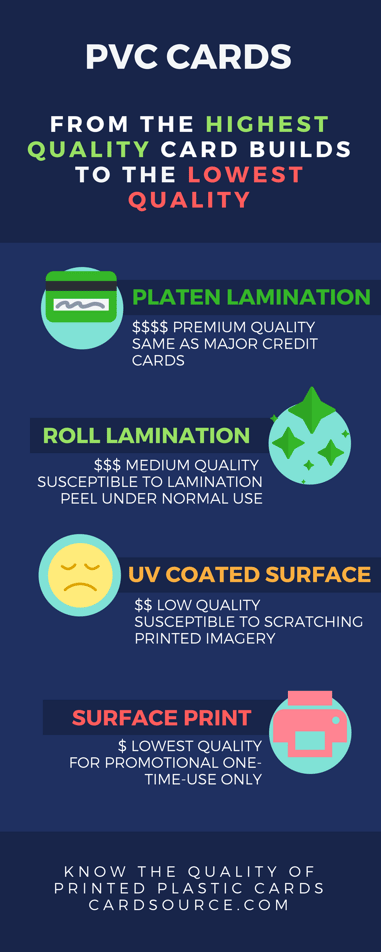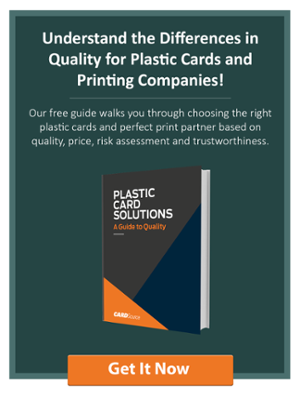There are four methods commonly used to construct PVC cards. It's important to understand the qualities of the cards you will be purchasing so you can choose the card type that is perfectly suited for your end user. Below, we will walk you through the highest quality card builds to the lowest quality, simultaneously showing pricing estimates.
Check out our infographic for a quick visual:

How do you choose the card type that will durable enough for your end user?
Let's break down the types even more, and explain how each type of card is manufactured.
- (Premium) Platen Lamination
- Heat and pressure are applied which binds the two-sided lamination together into the core PVC sheet to make one solid piece with clear PVC lamination protecting the print underneath. This recipe of card construction is widely considered to be the most polished and highest quality card build. This is proven by the major credit card companies of the world strictly using this method of plastic card construction.
- Price $$$$
- (Medium) Roll Laminated
- Similar in nature to Platen Lamination, but the lamination does not bond with core substrate through molecular heat and pressure but is rather laid on in roll format with adhesive applied between. Negative – Since the sheets are not truly bonded due to lack of pressure and heat in lamination, the durability and longevity of the lamination is reduced significantly. Most commonly found problem is delamination, corners start to peel with minimal usage.
- Price $$$
- (Low) UV Coated Surface Printed Cards
- Surface printed cards receive their print and are then coated with a UV curable finish on one or both sides. These cards are susceptible to scratching with minimum usage because the coating is not tough. These can be a valuable cost savings measure for bulk orders which have an intended short life span or one-time-use requirements.
- Price $$
- (Lowest) Surface Printed
- Core substrate is printed upon directly. Most commonly finished with a UV coating but not always. These are intended for cost savings on bulk orders for cards that will not be used by the recipient more than once – mainly for direct mail.
- Price $
It's easy to settle on a type of plastic card merely based on the price but, when it comes to plastic card products, you really do get what you pay for. The next time you're ordering cards, look at our helpful infographic to make sure you're picking the right quality for your consumers.
This information was taken out of our Plastic Card Solutions: A Guide to Quality eBook. Download your copy for free today:
Connect with us on social media to get updates on industry news, contests or deals!







